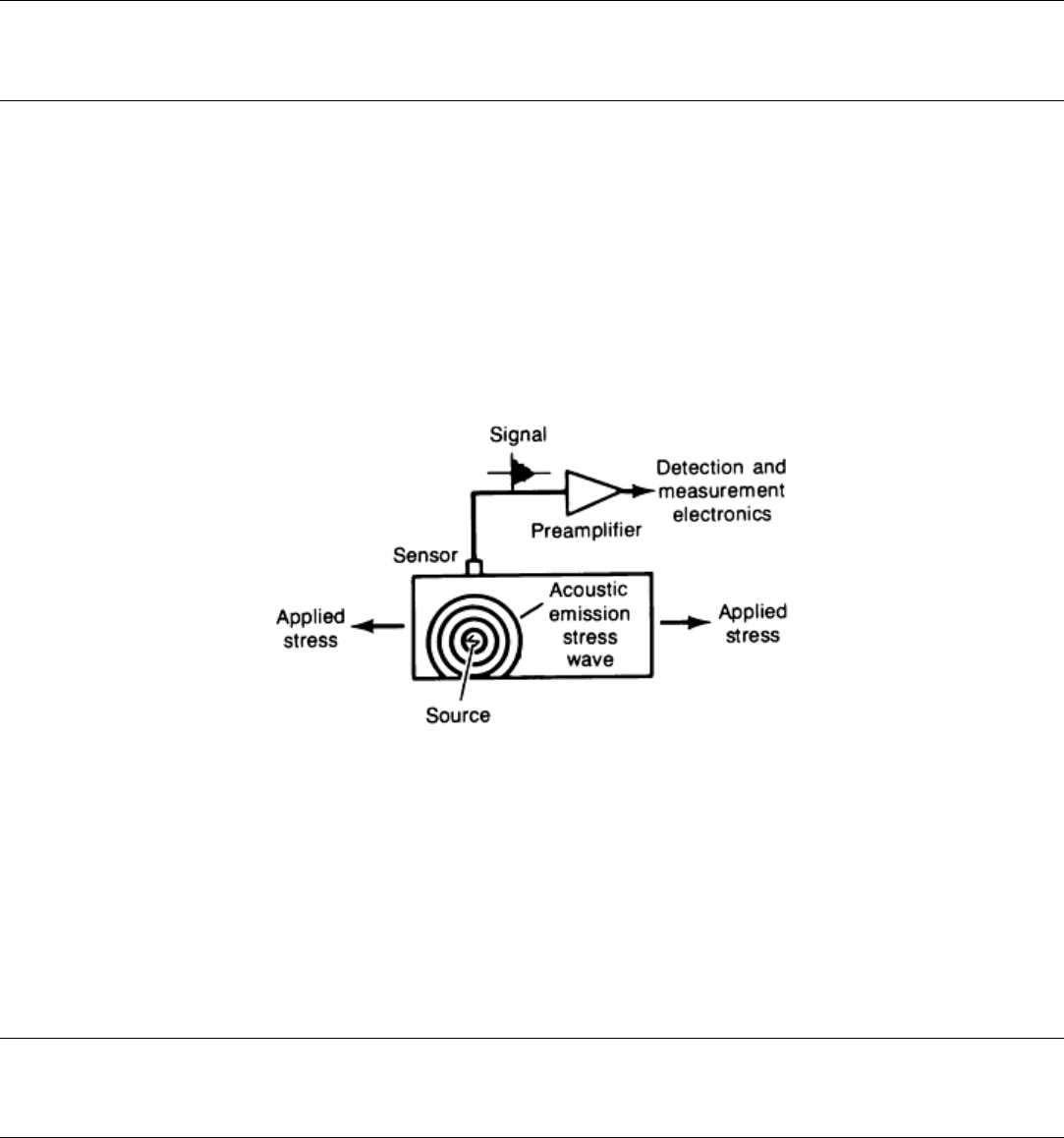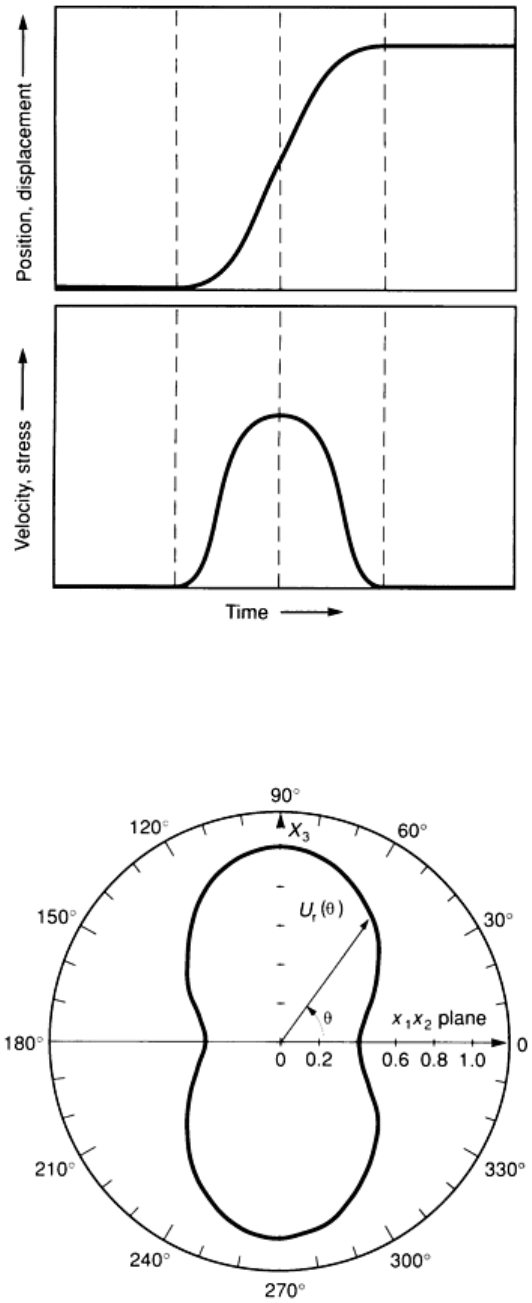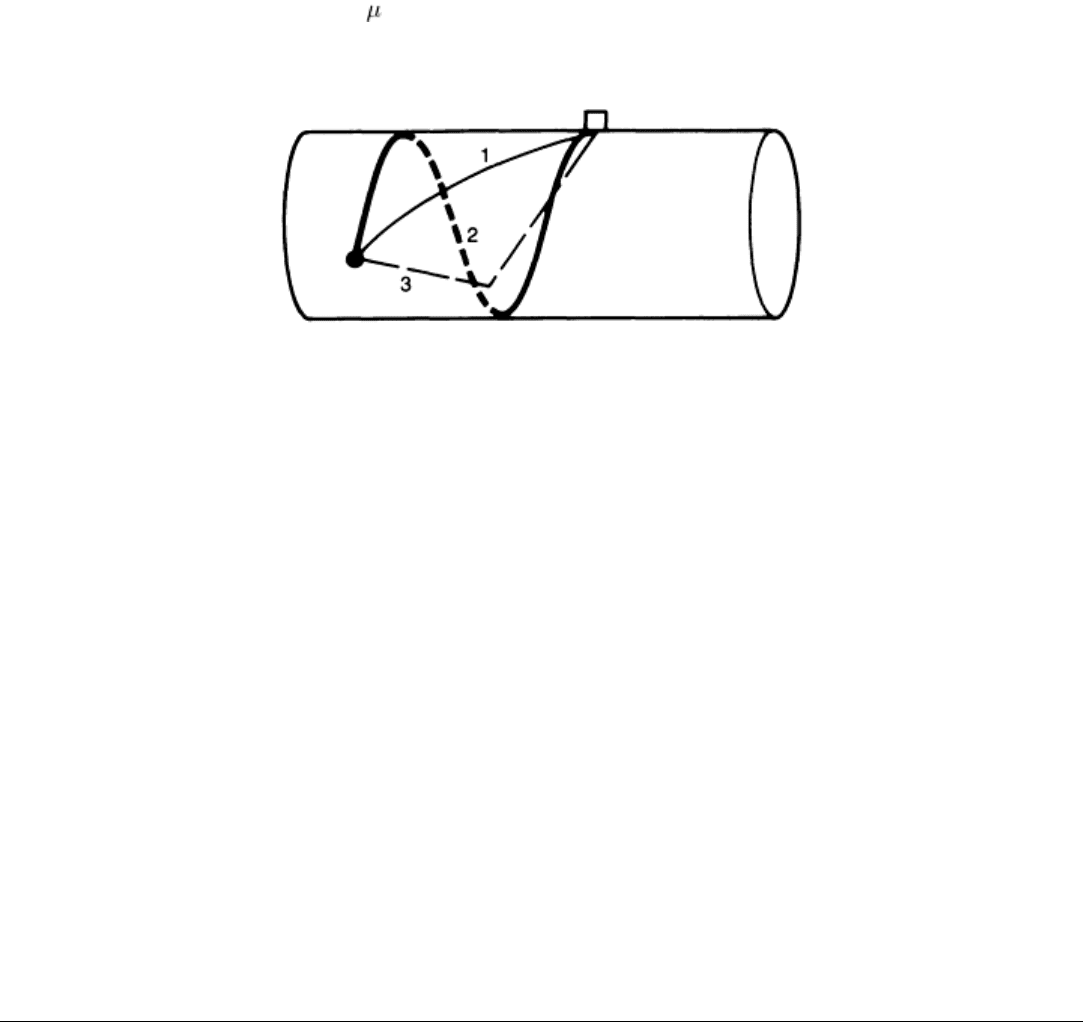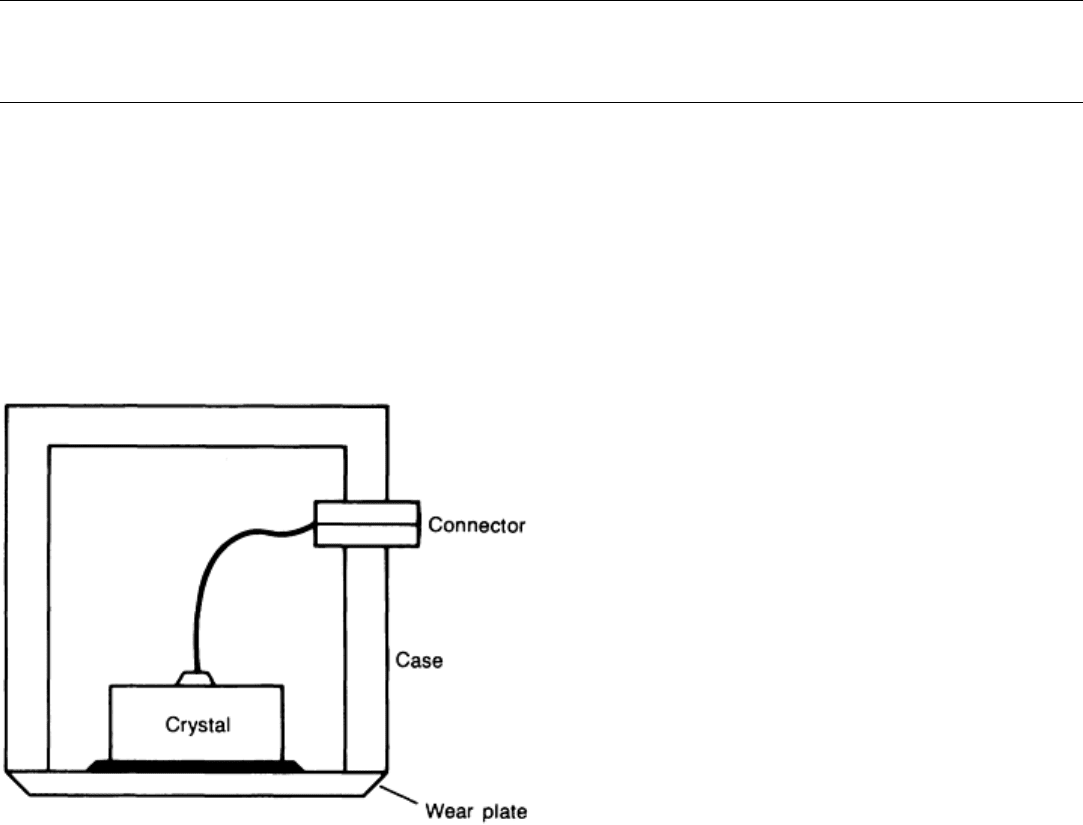ASM Metals HandBook Vol. 17 - Nondestructive Evaluation and Quality Control
Подождите немного. Документ загружается.


in Physical Acoustics: Principles and Methods,
Vol XVII, W.P. Mason and R.N. Thurston, Ed., Academic
Press, 1984, p 61-143
17.
A.V. Clark, J.C. Moulder, R.B. Mignogna, and P.P. DelSanto, "Comparison of Several Ultrasonic
Techniques for Absolute Stress Determination in the Presence of
Texture," National Bureau of Standards,
1987
Ultrasonic Inspection
Revised by Yoseph Bar-Cohen, Douglas Aircraft Company, McDonnell Douglas Corporation; Ajit K. Mal, University of California, Los
Angeles; and the ASM Committee on Ultrasonic Inspection
*
References
1. A.J. Krautkramer and H. Krautkramer, Ultrasonic Testing of Materials, 1st ed, Springer-Verlag, 1969
2. D. Ensminger, Ultrasonics, Marcel Dekker, 1973
3. Y. Bar-Cohen, NDE of Fiber Reinforced Composites--A Review, Mater. Eval.,
Vol 44 (No. 4), 1986, p
446-454
4. Y. Bar-Cohen, Nondestructive Characterization of Defects Using Ultrasonic Backscattering, in Ult
rasonic
International 87, Conference Proceedings, Butterworth, 1987, p 345-352
5. R. Halmshaw, Nondestructive Testing, Edward Arnold, 1987, p 198, 143, 211
6. Y. Bar-Cohen and A.K. Mal, Leaky Lamb Waves Phenomena in Composites Using Pulses, in
Review of
Progress in Quantitative NDE, Vol 8, D.P. Thompson and D.E. Chimenti, Ed., Plenum Press, 1989
7. A.K. Mal and Y. Bar-Cohen, Ultrasonic Characterization of Composite Laminates, in
Wave Propagation
in Structural Composites, Proceedings of the Joint ASME and SES meeting, AMD-
Vol 90, A.K. Mal and
T.C.T. Ting, Ed., American Society of Mechanical Engineers, 1988, p 1-16
8.
R.H. Grills and M.C. Tsao, Nondestructive Testing With Portable Ultrasonic Imaging System, in
Corrosion Monitoring in Industrial Plants Using Nondestructive Testing and Electromechanical Methods,
STP 908, American Society for Testing and Materials, 1987, p 89-101
9. E.A. Lloyd, Non-Destructive Testing of Bonded Joints--
A Case for Testing Laminated Structures by
Wide-Band Ultrasound, Non-Destr. Test., Dec 1974, p 331-334
10. P.J. Highmore, Non-Destructive Testing of Bonded Joints--The Depth Location of Non-Bonds in Multi-
Layered Media, Non-Destr. Test., Dec 1974, p 327-330
11. W.E. Garland, P.O. Ritter, and J.K. Fee, Applications of Ultrasoni
c Inspection to Composite Materials, in
Proceedings of the 7th Symposium on Nondestructive Evaluation of Components and Materials in
Aerospace and Nuclear Applications, Western Periodicals Company, 1969, p 226-238
12. Y. Bar-Cohen and A. K. Mal, Ultrasonic NDE of Adhesive Bonding, in Ultrasonic Testing,
Vol 8, ASNT
Handbook, American Society for Nondestructive Testing, to be published
13.
C.E. Lautzenheiser, A.G. Pickett, A.R. Whiting, and A.W. Wilson, "Ultrasonic Studies of Fatigue Crack
Initiation and P
ropagation," Paper presented at the Spring Convention, Los Angeles, American Society for
Nondestructive Testing, Feb 1965
14. C.E. Lautzenheiser, A.R. Whiting, and R.E. Wylie, Crack Evaluation and Growth During Low-
Cycle
Plastic Fatigue--Nondestructive Techniques for Detection, Mater. Eval., May 1966, p 241-248
15.
J.F. Cook, D.A. Aldrich, B.C. Anderson, and V.S. Scown, Development of an Automated Ultrasonic
Inspection System for Verifying Waste Container Integrity, Mater. Eval., Dec 1984
16. Y.H. Pao, W
. Sachse, and H. Fukuoka, Acoustoelasticity and Ultrasonic Measurement of Residual
Stresses, in Physical Acoustics: Principles and Methods,
Vol XVII, W.P. Mason and R.N. Thurston, Ed.,
Academic Press, 1984, p 61-143
17. A.V. Clark, J.C. Moulder, R.B. Mign
ogna, and P.P. DelSanto, "Comparison of Several Ultrasonic

Techniques for Absolute Stress Determination in the Presence of Texture," National Bureau of Standards,
1987
Ultrasonic Inspection
Revised by Yoseph Bar-Cohen, Douglas Aircraft Company, McDonnell Douglas Corporation; Ajit K. Mal, University of California, Los
Angeles; and the ASM Committee on Ultrasonic Inspection
*
Selected References
• L. Adler and D. Fitting, Ultrasonic Spectral Analysis for Nondestructive Evaluation, Plenum, 1981
• G.V. Blessing, "An Assessment of Ultrasonic Reference Block Calibration Methodology," NBSIR 83-
2710,
National Bureau of Standards, 1983
• C.E. Burley, Calibration Blocks for Ultrasonic Testing, in Nondestructive Testing Standards--
A Review,
STP 642, H. Berger, Ed., American Society for Testing and Materials, 1977
• S. Golan, "A Comparison of American and European Ultrasonic Testing Standards," NBSIR 79-
1790,
National Bureau of Standards, 1979
• R.E. Green, Ultrasonic Investigation of Mechanical Properties, Academic Press, 1973
• G.C. Knollman and R.C. Yee, Ultrasonic-
Image Evaluation of Microstructural Damage Accumulation in
Materials, Exp. Mech., Vol 28 (No. 2), June 1988, p 110-116
• J. Krautkramer and H. Krautkramer, Ultrasonic Testing of Materials, 3rd ed., Springer-Verlag, 1983
• T.M. Mansour, Ultrasonic Inspection of Spot Welds in Thin-Gage Steel, Mater. Eval., Vol 46 (No.
5), April
1988, p 650-658
• M.G. Silk, Ultrasonic Transducers for NDE, Adam Hilger, 1984
• M. Stringfellow and B. Hawker, Scanner Improves Ultrasonic Inspection of Austenitic Material, Atom,
No.
381, July 1988, p 16-21
• A. Vary, Material Analysis by Ultrasonics, Noyes Data Corporation, 1987
•
A. Vary, Concepts for Interrelating Ultrasonic Attenuation, Microstructure, and Fracture Toughness in
Polycrystalline Solids, Mater. Eval., Vol 46 (No. 5), April 1988, p 642-649
• S.Y. Zhang, J.Z. Shen, and C.F.
Ying, The Reflection of the Lamb Wave by a Free Plate Edge:
Visualization and Theory, Mater. Eval., Vol 46 (No. 5), April 1988, p 638-641

Acoustic Emission Inspection
Adrian A. Pollock, Physical Acoustics Corporation
Introduction
ACOUSTIC EMISSIONS are stress waves produced by sudden movement in stressed materials. The classic sources of
acoustic emissions are defect-related deformation processes such as crack growth and plastic deformation. The process of
generation and detection is illustrated in Fig. 1. Sudden movement at the source produces a stress wave, which radiates
out into the structure and excites a sensitive piezoelectric transducer. As the stress in the material is raised, many of these
emissions are generated. The signals from one or more sensors are amplified and measured to produce data for display
and interpretation.
Fig. 1 Basic principle of the acoustic emission method
The source of the acoustic emission energy is the elastic stress field in the material. Without stress, there is no emission.
Therefore, an acoustic emission (AE) inspection is usually carried out during a controlled loading of the structure. This
can be a proof load before service, a controlled variation of load while the structure is in service, a fatigue test, a creep
test, or a complex loading program. Often, a structure is going to be loaded anyway, and AE inspection is used because it
gives valuable additional information about the performance of the structure under load. Other times, AE inspection is
selected for reasons of economy or safety, and a special loading procedure is arranged to meet the needs of the AE test.
Acoustic Emission Inspection
Adrian A. Pollock, Physical Acoustics Corporation
Relationship to Other Test Methods
Acoustic emission differs from most other nondestructive testing (NDT) methods in two key respects. First, the signal has
its origin in the material itself, not in an external source. Second, acoustic emission detects movement, while most other
methods detect existing geometrical discontinuities. The consequences of these fundamental differences are summarized
in Table 1.
Table 1 Characteristics of acoustic emission inspection compared with other inspection methods

Acoustic emission Other methods
Detects movement of defects Detect geometric form of defects
Requires stress Do not require stress
Each loading is unique Inspection is directly repeatable
More material-sensitive Less material-sensitive
Less geometry-sensitive More geometry-sensitive
Less intrusive on plant/process
More intrusive on plant/process
Requires access only at sensors
Require access to whole area of inspection
Tests whole structure at once Scan local regions in sequence
Main problems: noise related Main problems: geometry related
Often in NDT there is no one method that can provide the whole solution; for cost effectiveness, technical adequacy, or
both, it is best to use a combination of methods. Because acoustic emission has features that distinguish it so sharply from
other methods, it is particularly useful when used in combination with them.
A major benefit of AE inspection is that it allows the whole volume of the structure to be inspected nonintrusively in a
single loading operation. It is not necessary to scan the structure looking for local defects; it is only necessary to connect a
suitable number of fixed sensors; which are typically placed 1 to 6 m (4 to 20 ft) apart. This leads to major savings in
testing large structures, for which other methods require removal of insulation, decontamination for entry to vessel
interiors, or scanning of very large areas.
Typically, the global AE inspection is used to identify areas with structural problems, and other NDT methods are then
used to identify more precisely the nature of the emitting defects. Depending on the case, acceptance or rejection can be
based on AE inspection alone, other methods alone, or both together.
Acoustic Emission Inspection
Adrian A. Pollock, Physical Acoustics Corporation
Range of Applicability
Acoustic emission is a natural phenomenon occurring in the widest range of materials, structures, and processes. The
largest-scale acoustic emissions are seismic events, while the smallest-scale processes that have been observed with AE
inspection are the movements of small numbers of dislocations in stressed metals. In between, there is a wide range of
laboratory studies and industrial testing.

In the laboratory, AE inspection is a powerful aid to materials testing and the study of deformation and fracture. It gives
an immediate indication of the response and behavior of a material under stress, intimately connected with strength,
damage, and failure. Because the AE response of a material depends on its microstructure and deformation mode,
materials differ widely in their AE response. Brittleness and heterogeneity are two major factors conducive to high
emissivity. Ductile deformation mechanisms, such as microvoid coalescence in soft steels, are associated with low
emissivity.
In production testing, AE inspection is used for checking and controlling welds (Ref 1), brazed joints (Ref 2),
thermocompression bonding (Ref 3), and forming operations such as shaft straightening (Ref 4) and punch press
operations. In general, AE inspection can be considered whenever the process stresses the material and produces
permanent deformation.
In structural testing, AE inspection is used on pressure vessels (Ref 5), storage tanks (Ref 5), pipelines and piping (Ref 6),
aircraft and space vehicles (Ref 7), electric utility plants (Ref 7), bridges (Ref 7), railroad tank cars (Ref 8), bucket trucks
(Ref 7), and a range of other equipment items. Acoustic emission tests are performed on both new and in-service
equipment. Typical uses include the detection of cracks, corrosion, weld defects, and material embrittlement.
Procedures for AE structural testing have been published by The American Society of Mechanical Engineers (ASME), the
American Society for Testing and Materials (ASTM), and other organizations. Successful structural testing comes about
when the capabilities and benefits of AE inspection are correctly identified in the context of overall inspection needs and
when the correct techniques and instruments are used in developing and performing the test procedure (Ref 9).
Acoustic emission equipment is highly sensitive to any kind of movement in its operating frequency range (typically 20 to
1200 kHz). The equipment can detect not only crack growth and material deformation but also such processes as
solidification, friction, impact, flow, and phase transformations. Therefore, AE techniques are also valuable for:
• In-process weld monitoring (Ref 10)
• Detecting tool touch and tool wear during automatic machining (Ref 10)
• Detecting wear and loss of lubrication in rotating equipment (Ref 10), and tribological studies (Ref 11)
• Detecting loose parts and loose particles (Ref 12)
• Detecting and monitoring leaks, cavitation, and flow (Ref 12, 13)
• Monitoring chemical reactions, including corrosion processes (Ref 14), liquid-
solid transformations, and
phase transformations (Ref 14)
When these same processes of impact, friction, flow, and so on, occur during a typical AE inspection for cracks or
corrosion, they constitute a source of unwanted noise. Many techniques have been developed for eliminating or
discriminating against these and other noise sources. Noise has always been a potential barrier to AE applicability. This
barrier is constantly being explored and pushed outward, bringing previously impractical projects into the realm of
feasibility.
References cited in this section
1. Acoustic Emission Testing, Vol 5, 2nd ed., Nondestructive Testing Handbook,
R.K. Miller and P. McIntire,
Ed., American Society for Nondestructive Testing, 1987, p 275-310
2. T.F. Drouillard and T.G. Glenn, Production Acoustic Emission Testing of Braze Joint, J. Acoust. Emiss.,
Vol 1 (No. 2), 1985, p 81-85
3.
S.J. Vahaviolos, Real Time Detection of Microcracks in Brittle Materials Using Stress Wave Emission
(SWE), IEEE Trans., Vol PHP-10 (No. 3), Sept 1974, p 152-159
4. K.H. Pärtzel, Acoustic Emission for Crack In
spection During Fully Automatic and Manual Straightening of
Transmission Shafts, in Proceedings of the Acoustic Emission Symposium
(Bad Nauheim), J. Eisenblätter,
Ed., Deutsche Gesellschaft für Metallkunde, 1988, p 157-164
5. Acoustic Emission Testing, Vol 5, 2nd ed., Nondestructive Testing Handbook,
R.K. Miller and P. McIntire,
Ed., American Society for Nondestructive Testing, 1987, p 167-186, 187-193

6. D.L. Parry, Industrial Application of Acoustic Emission Analysis Technology, in Monitoring Structural
Integrity by Acoustic Emission, STP 571, American Society for Testing and Materials, 1975, p 150-183
7. Acoustic Emission Testing, Vol 5, 2nd ed., Nondestructive Testing Handbook,
R.K. Miller and P. McIntire,
Ed., American Society for Nondestructive Testing, 1987, p 421-424, 434-443, 226-259, 333-339, 267-271
8.
T.J. Fowler, Recent Developments in Acoustic Emission Testing of Chemical Process Equipment, in
Progress in Acoustic Emission IV, Proceedings of the Ninth International Acoustic Emission Symposiu
m,
The Japanese Society for Non-Destructive Inspection, 1988, p 391-404
9. P.C. Cole, Acoustic Emission, in The Capabilities and Limitations of NDT,
Part 7, The British Institute of
Non-Destructive Testing, 1988
10.
Acoustic Emission Testing, Vol 5, 2nd ed., Nondestructive Testing Handbook,
R.K. Miller and P. McIntire,
Ed., American Society for Nondestructive Testing, 1987, p 278, 472-484, 213-219
11.
S.L. McBride, Acoustic Emission Measurements on Rubbing Surfaces, in
Proceedings of the World
Meeting on Acoustic Emission (Charlotte, NC), Acoustic Emission Group, March 1989
12.
Acoustic Emission Testing, Vol 5, 2nd ed., Nondestructive Testing Handbook,
R.K. Miller and P. McIntire,
Ed., American Society for Nondestructive Testing, 1987, p 402-408, 194-202
13.
A.A. Pollock and S.-Y.S. Hsu, Leak Detection Using Acoustic Emission, J. Acoust. Emiss.,
Vol 1 (No. 4),
1982, p 237-243
14.
Acoustic Emission Testing, Vol 5, 2nd ed., Nondestructive Testing Handbook,
R.K. Miller and P. McIntire,
Ed., American Society for Nondestructive Testing, 1987, p 58-61, 84-88
Acoustic Emission Inspection
Adrian A. Pollock, Physical Acoustics Corporation
Acoustic Emission Waves and Propagation
The primitive wave released at the AE source is illustrated in Fig. 2. The displacement waveform is basically a steplike
function corresponding to the permanent change associated with the source process. The corresponding velocity and
stress waveforms are basically pulselike. The width and height of the primitive pulse depend on the dynamics of the
source process. Source processes such as microscopic crack jumps and precipitate fractures are often completed in a few
microseconds or fractions of a microsecond, so the primitive pulse has a correspondingly short duration. The amplitude
and energy of the primitive pulse vary over an enormous range from submicroscopic dislocation movements to gross
crack jumps. The primitive wave radiates from the source in all directions, often having a strong directionality depending
on the nature of the source process, as shown in Fig. 3. Rapid movement is necessary if a significant amount of the elastic
energy liberated during deformation is to appear as an acoustic emission.

Fig. 2
Primitive AE wave released at a source. The primitive wave is essentially a stress pulse corresponding to
a permanent displacement of the material.
Fig. 3
Angular dependence of acoustic emission radiated from a growing microcrack. Most of the energy is
directed in the 90 and 270° directions, perpendicular to the crack surfaces.

The form of the primitive wave is profoundly changed during propagation through the medium, and the signal emerging
from the sensor has little resemblance to the original pulse. This transformation of the AE waveform is important both to
the researcher interested in source function analysis and to the practical NDT inspector interested in testing structures.
The researcher who wants to determine the original source waveform uses broadband sensors and performs a detailed
analysis of the early part of the received signal. This is an important but very demanding line of inquiry. It may take an
hour of computer time to process a single waveform. Most materials-oriented researchers, along with NDT inspectors, are
interested in broader statistical features of the AE activity and do not need to know the precise details of each source
event. They use narrowband sensors and electronic equipment that measures only a few features of the received
waveform but is able to process hundreds of signals per second. The salient wave propagation factors are different for
these two lines of work, as discussed below.
Factors in Source Function Analysis. The relationship between the source pulse and the resulting movement at the
point of detection has been intensively studied during the last 10 to 15 years. Research groups at the NDT Centre at
Harwell, UK (Ref 15), the National Bureau of Standards (Ref 16), Cornell University (Ref 17), and the University of
Tokyo (Ref 18) have led the attack on this surprisingly difficult problem. A long-term goal of these studies has been to
learn how to calculate a description of the source event from observation of the output of a distant sensor.
The difficulty of the problem is indicated in Fig. 4, which shows the vertical component of the surface movement at point
B, resulting from the abrupt application of a vertical force at point A on a semi-infinite body. Even with this simple
geometry and source function, the resulting waveform is quite complicated. In the case of a plate, it is more complicated
yet, because the second surface also plays its role in the elasto-dynamics of the wave propagation process. In plates, the
motion at the point of detection depends strongly on the ratio of source distance to plate thickness.
Fig. 4
Displacement waveform produced by an abrupt application of a downward force at point A. The
waveform can be viewed as either a "snapshot" of surface displacement (in which case x
= position) or as a
graph of the displacement at point B as a function of time (x = time).
In addition, the source function is not instantaneous, it will in fact be a force dipole and/or double couple rather than a
point force, its orientation is in general unknown, and horizontal as well as vertical components of motion need to be
considered. With these complications, it has understandably taken many years of effort to develop mathematical theory,
computational tools, and experimental techniques equal to the task of calculating the source function.

In recent years, the leading laboratories have attained the ability to quantify crack growth increments, orientations, and
time characteristics in some of the simpler specimen geometries ordinarily encountered (Ref 19). High-fidelity sensors
must be used, and the analysis involves only the first part of the AE waveform, which is recorded in full detail with a
high-performance transient recorder. This effort in the characterization of the source pulse has been one of the leading
areas of AE research, and it can be expected eventually to yield returns in applied NDT.
Factors in Source Location and Typical AE Measurements. Whereas source function analysis utilizes only the
first part of the AE waveform, mainstream AE technology accepts the waveform in its entirety. The later part of this
waveform is made up of many components reaching the sensor by a variety of paths. Figure 5 illustrates this principle, but
shows only a few of the indefinitely large number of possible paths by which the wave can reach the sensor. Typically,
the highest peak in the waveform is produced, not by the first component, but by the constructive interference of several
of the later components. The AE wave bounces around the testpiece, repeatedly exciting the sensor until it finally decays
away. This decay process may take 100 s in a highly damped, nonmetallic material or tens of milliseconds in a lightly
damped, metallic material--much longer than the source event, which is usually finished in a few microseconds or less.
Fig. 5 Three possible paths from source to sensor in a water-filled pipe.
1, direct path; 2, spiral path; 3,
waterborne path
It is important to understand that the shape of the received waveform is fundamentally the result of these wave
propagation processes. Other important aspects of wave propagation in typical AE testing are attenuation and wave
velocity. Attenuation is the loss of signal amplitude due to geometric factors and material damping as the wave travels
through the material (Ref 20). Attenuation governs detectability at a distance and is therefore an important factor in
choosing sensor positions and spacing. Acoustic emission procedures typically call for attenuation measurements to be
made before a test and specify permissible sensor spacing based on these measurements.
Wave velocity is an additional factor to be considered when AE technology is used for source location. Source location is
an important technique that is widely used both in laboratory studies and in structural testing. It is particularly significant
in testing large structures, for which AE inspection is used to identify active regions for conclusive follow-up inspection
with other NDT methods. Large cost savings have been realized through this combination of global AE inspection and
focused inspection by other methods.
There are several strategies for source location. Zone location places the source within a broad area. Point location places
the source precisely, by calculating from the relative arrival times of the AE wave at several sensors. Wave velocity is
involved in these calculations. The attainable accuracy is governed by wave propagation processes and depends on such
factors as geometry, plate thickness, and contained fluids. In effect, these factors render the wave velocity uncertain and
this leads to errors in source location. In favorable cases, the attainable accuracy is better than 1% of the sensor spacing;
in unfavorable cases, worse than 10%. The wave propagation effects underlying these variations are reviewed in Ref 20.
References cited in this section
15.
C.B. Scruby, Quantitative Acoustic Emission Techniques, in
Research Techniques in Nondestructive
Testing, Vol VIII, R.S. Sharpe, Ed., Academic Press, 1985, p 141-210
16.
Acoustic Emission Testing, Vol 5, 2nd ed., Nondestructive Testing Handbook,
R.K. Miller and P. McIntire,
Ed., American Society for Nondestructive Testing, 1987, p 64-90

17.
Y.H. Pao, Theory of Acoustic Emission, in Elastic Waves and Non-Destructive Testing of Materials, AMD-
20, American Society of Mechanical Engineers, 1978, p 107-128
18.
M. Enoki, T. Kishi, and S. Kohara, Determination of Microcracking Moment Tensor of Quasi-
Cleavage
Facet by AE Source Characterization, in Progress in Acoustic Emission III,
Proceedings of the Eighth
International Acoustic Emission Symposium, The Japanese Society for Non-
Destructive Inspection, 1983, p
763-770
19.
S. Yuyama, T. Imanaka, and M. Ohtsu, Quantitative Evaluation of Microfracture Due to Disbonding by
Waveform Analysis of Acoustic Emission, J.Acoust. Soc. Am., Vol 83 (No. 3), 1988, p 976-
983; Vol 82
(No. 2), 1987, p 506-512
20.
A.A. Pollock, Classical Wave Theory in Practical AE Testing, in Progress in Acoustic Emission III,
Proceedings of the Eighth International Acoustic Emission Symposium, The Japanese Society for Non-
Destructive Inspection, 1986, p 708-721
Acoustic Emission Inspection
Adrian A. Pollock, Physical Acoustics Corporation
Acoustic Emission Sensors and Preamplifiers
*
The key element in an AE resonant sensor is a piezoelectric crystal (transducer) that converts movement into an electrical
voltage. The crystal is housed in a suitable enclosure with a wear plate and a connector, as shown in Fig. 6. The sensor is
excited by the stress waves impinging on its face, and it delivers an electrical signal to a nearby preamplifier and then to
the main signal-processing equipment. The preamplifier can be miniaturized and housed inside the sensor enclosure,
facilitating setup and reducing vulnerability to electromagnetic noise.
Sensor Response. One of the most sought-after
properties in an AE sensor is high sensitivity. Although
high-fidelity, flat frequency response sensors are available,
most practical AE testing employs resonant-type sensors
that are more sensitive, as well as less costly, than the flat
frequency response type. These sensors have one or more
preferred frequencies of oscillation, governed by crystal
size and shape. These preferred frequencies actually
dominate the waveform and spectrum of the observed
signal in typical AE testing.
The sensitivity calibration of AE sensors was the subject of
a substantial developmental program at the National Bureau
of Standards (NBS) through the late 1970s. This program
has led to the routine availability of NBS-traceable plots
showing the absolute sensitivity of AE sensors in volts per
unit velocity as a function of frequency (Ref 21).
Acoustic Emission Waveform Transformation. In
addition to the wave propagation factors discussed earlier,
the transformation of a single AE waveform is further
compounded by the sensor response. When a resonant
sensor is excited by a broadband transient pulse, it rings like a bell at its own natural frequencies of oscillation. Therefore,
the electrical signal at the sensor output is the product of this ringing, thus compounding the effects of multiple paths and
multiple wave modes by which the wave travels from source to sensor. A typical AE signal from a piezoelectric sensor is
shown in Fig. 7; the radical difference between this observed signal and the simple waveform at the source (Fig. 2) cannot
be overemphasized.
Fig. 6 Typical construction of an AE resonant sensor
